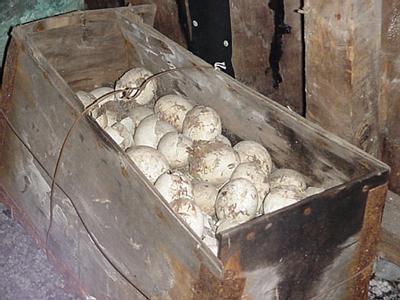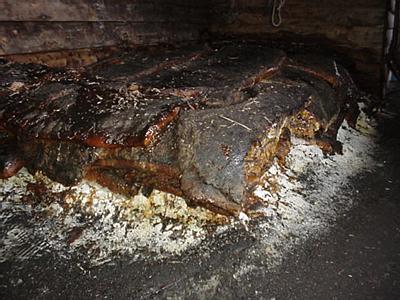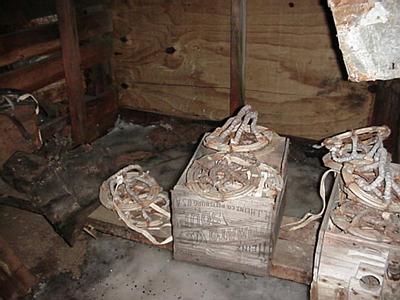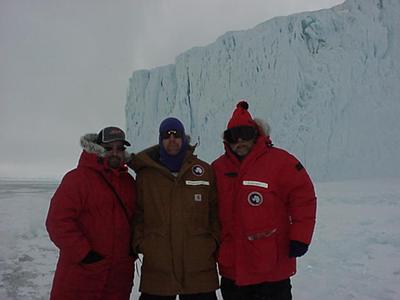
|
|
28 November, 1999
Sunday November 28, 1999
Got up at 0500 hours straighted up my room and tried to do laundry.
Evidently other early risers had the same plan. I'll have to do it tonight,
not that I have a lot of it, but the stuff I do have is pretty ripe and I
have to keep beating it with a stick to keep it in the laundry bag.
Came over to the Crary lab about o530 and sent out journals and picture. The
gathered up materials for a meting with one of our parcticipants. I hope
this meeting goes well and goes quickly for I'd like to catch a nap before I
go on the Cape Evans tour. If you recall from a previous email the last
time I got this chance we were not allowed into the hut because some DV
(Distinguished Visitor) had not returned the key.
Meeting went well and the young fellow I spent two hours is really
enthusiastic and full of wonderful and exciting ideas. He is a "fuelie",
that is someone who delivers, monitors, pumps and stores fuel, the life line
here in Antarctica. No fuel, no planes, no planes no people, no fuel no,
heat and again no people. No matter how you look at it this is an
extremely important job.
Had just time to get ECW gear and get to place where Deltas picked us up.
This trip to cape Evans was better, if there can be such a thing, then the
last one. I thought it was surreal seeing boxes of food store outside and
still being able to read the labels, hay for the Manchurian ponies that
Scott had, and the mummified remains of a dog last time. When they unlocked
the door and gave me a flashlight to walk in and look around, what would be
the stable area, it simply blew me away. There on the left as I entered was
the remains of a bicycle, even these most hardy of men had sense of humor.
Immediately behind the bicycle was a must less frivolous commodity, a box of
penguin eggs. As I proceeded around the corner there was a stack , about 4'
wide by 6' long by 3' thick, of "fresh" (now some 80 +years old) strips of
seal blubber about 1'x6'x5" thick. The blubber was as they had left it.
This would have been used for food as well as fuel for the blubber stove, a
stove that generated a lot of heat, but a tremendous amount of soot as well.
As I turned the corner I entered the stable proper. There were, I believe 6
stalls, each had a feed bag and water trough and on the back wall where each
pony had his name printed, hung his bridle and his "snowshoes". Amazing!
But wait, we still have to get into the living quarters. I walked back to
the door, but I guess I was not destined to see the inside, for the last
person who had been there somehow jammed the latch. The young Delta drive,
with help from several people and suggestions from everyone else, played
with this latch for about 20 minutes and finally got in.
The building was as structurally tight as could be, and it was very dark for
there were but three small windows and they were quite dirty and in one case
almost buried in snow. As I entered there was a room with a table and
supplies of all sorts, from food to worm medicine for the ponies. They were
neatly stacked and obviously grouped by what they were.
The hut was probably 25' wide by maybe 30' long. Please remember this hut,
all of it, was brought here by ship as was every single bottle, can, book,
nail, board screw, hammer, EVERYTHING. And God help you if you forgot
something. At various points around the room two sets of bunk beds divided
the area into lillte cubbies. The bunks still had items of clothing and
boots on them, one of the table still had dinnerware. These compartments
created by the rows of bunks and separated by blankets evidently served as a
small galley, and a couple of small science labs. There was a room in the
middle back of the hut that was actually closed off by a door, from what was
laying around it appears to have been the "darkroom" for the expedition.
In the far back left hand corner, next to one of the windows was an area
where the biologist in the group evidently did his thing. There were
several specimens of bones on the counter, but the most amazing thing was an
emperor penguin that evidently was just about to be dissected when the hut
was abandoned. The penguin could have died yesterday it was totally in
tack.
As I stood in the dim light all I could do was try to imagine being here
totally alone, totally without communication and for at least 6 months, in
total darkness. I cannot imagine this. I am in total awe. Goose-bumps
popped up I think all over me and tears filled my eyes. All I can think of
are some the final word's that I believe Scott wrote in his diary not too
long before he lost his battle with Mother Nature, "God this is an awful
place". I left the hut a better person, but no wiser as to how or way anyone
would take on such a challenge.
Outside the sun was still bright, but the wind had picked up. I saw a
couple of people walking over toward the glacier ice wall and decided to
join them. By the time I got about 3/4 the way to them they had stopped
and were headed back. We met and chatted and I think all of us really wanted
to go over the base of the glacier, but for some reason didn't want to say
it or maybe really do it. I asked if anyone would go with me and it was a
done deal. We were off. The glacier was about two mile form the hut and we
had a little more then 2 hours to return, so we had plenty of time. One of
the fellows was from Nebraska and the other from Florida. As we approached
the glacier we talked less and stared in amazement more. The immense size,
our estimates ranged from 140' to 200' tall. Probably more like the latter,
but who cares, that is still a 14-story building and the colors gave all of
us a feeling of being a very very small speck of dust on an enormously large
sheet of turquoise blue and white ice. We became totally insignificant
compared to our surroundings. This turned out to be another of those once in
500 lifetime "Kodak moments" and the cameras clicked away.
We watched the clock and new it was time to get back. When we were within
10 minutes of the Deltas and still had 15 minutes to make it to them the
drivers, evidently trying to get the attention of five others who were still
at the glacier wall, decided to move the two Deltas. Let me tell you, the
three of us and I am sure the five others who were way behind us, had
strange thoughts of being abandonded. We knew this wouldn't happen, but my
God what if it did? Needless to say the five stragglers made outstanding
time back to the Deltas. The trip back was fun. I road up front with the
driver and the fellow from Nebraska and we shared jokes and our life
histories, at least as much as you can in 1 1/4 hour span of time.
I went to my dorm, changed and returned to the galley for dinner. I
immediatley returned to my dorm and went to bed. I gues around 2100 hours I
was awaked by someone comiing into my room. I had a new roommate, some one
who called himself "Blue" from Ohio State University. I guess I must have
fallen back to sleep because it is now morning and Blue is cutting Z's in
the bunk above me.
Ciao,
Penguin Pet the Polar man

Here is a picture of the front of the glacier at Cape Evans. The two people in the fore ground are each over six feet tall. This should give you some idea of the enormity of this. <> Photo by Peter M. Amati, Jr.

This is a box of penguin eggs. They were used for food as well aas specimens of scientific investigations. Photo by Peter M. Amati, Jr. <>

A large stack of strips of seal bubbler. This blubber was used as food and also as a fuel to cook and heat with. <> Photo by Peter M. Amati, Jr

Snowshoes for the ponies to prevent them from sinking into the snow. They work the same way all snowshoes work, namely to spread the weight out over a greater surface area, therefore putting less pressure on each square inch. This is the same principle that LC-130 s use when they are ski equipped. <> Photo by Peter M. Amati, Jr.

One of the bunk beds in Scott's hut. I believe there were sixteen altogether. Notice the bedding on the bunk and the candle that they used for light. Even now in the summer it was dark in the hut. I cannot imagine living there with 24 hours of darkness for almost six months straight. <> Photo by Peter M. Amati, Jr.

Melvin (Florida), Erik (Nebraska) and me (Massachusetts) stand in awe that, first of all we are here at the bottom of the world and second of all that we have had a chance to see things such as the glacier in the background.. <> Photo y Peter M. Amati, Jr.
Contact the TEA in the field at
.
If you cannot connect through your browser, copy the
TEA's e-mail address in the "To:" line of
your favorite e-mail package.
|
